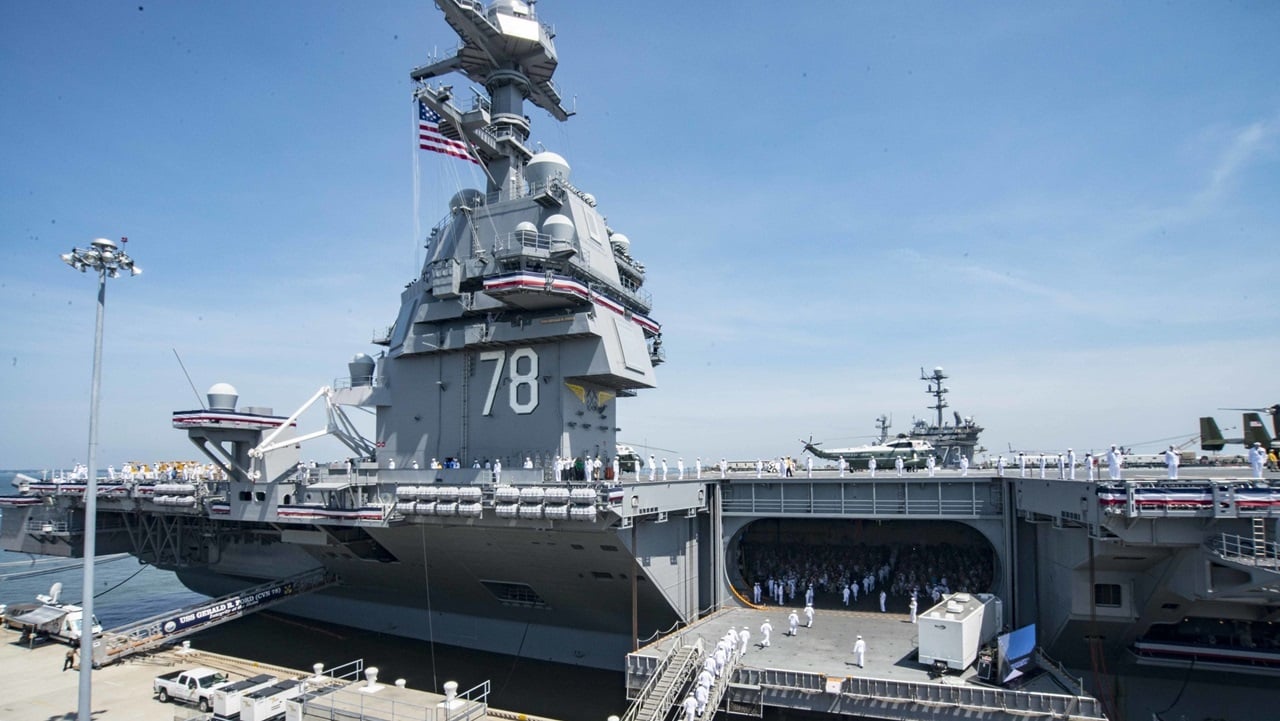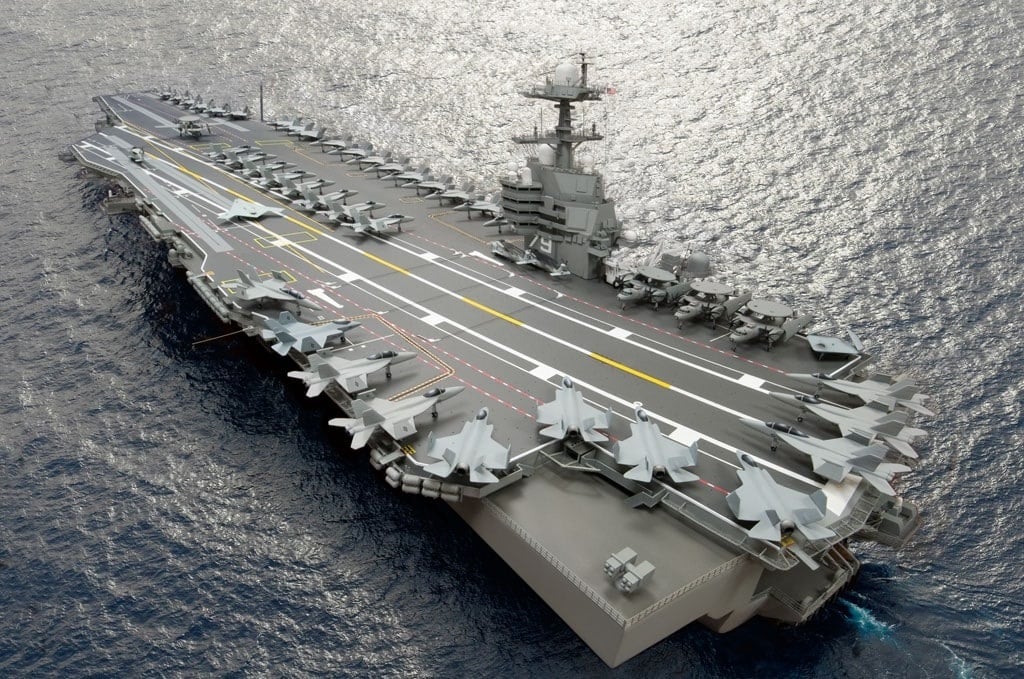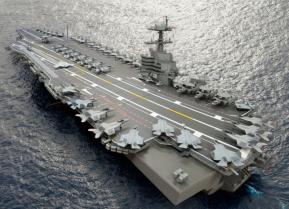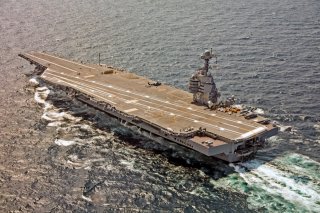Ford-Class: Largest and Most Expensive U.S. Navy Aircraft Carrier Ever
The Ford's massive price tag is difficult to comprehend. The $13 billion per unit is just part of the equation. The program itself has, so far, cost $120 billion – more than $40 billion beyond the initial cost projection of $77 billion. Are the runaway program costs worth it?
Meet the Ford-Class Aircraft Carrier: Perhaps no single piece of military equipment speaks to a nation’s prosperity and prestige like the nuclear aircraft carrier.
The vast majority of the world’s navies sail without an aircraft carrier of any kind; creating, maintaining, and operating an aircraft carrier is a special kind of burden, requiring nuanced expertise and vast resources.
So, when a nation is capable of fielding an aircraft carrier, nuclear or otherwise, the carrier places that nation in a rarified group of the world’s most capable and most affluent.
However, not all aircraft carriers are created equal; not all aircraft carriers confer equal amounts of prestige upon the national operator.
Russia’s lone carrier, the Admiral Kuznetsov, is barely seaworthy, relying upon an outdated fuel, called mazut, to power gas turbines.
China meanwhile started its carrier fleet with secondhand carriers from other nations.
Indeed, not all aircraft carriers are created equal – and the current standard-bearer, the most prestige-conferring, is the United States’s Ford-class carrier – which happens to be the most expensive warship ever built at $13 billion per unit.
Ford-Class: Unprecedented Investment
The Ford-class’s massive price tag is difficult to comprehend. The $13 billion per unit is just part of the equation. The program itself has, so far, cost $120 billion – more than $40 billion beyond the initial cost projection of $77 billion. Are the runaway program costs worth it?
The function of an aircraft carrier – to project air power roughly anywhere around the world – is a remarkable function, capable of expanding the US force function exponentially. While the US is arguably over-eager to meddle militarily in global affairs, the ability to project air power around the world is an enviable ability that most would argue is well worth investing in. But $13 billion per Ford-class carrier? What are we getting at that price?

Well, because the aircraft carrier exists to project airpower globally, the rate at which aircraft are able to launch from a carrier is a crucial metric in gauging a carrier’s effectiveness. The Navy even has a name for the metric: Sortie Generation Rate, or SGR. And although most people have never heard of an SGR, it’s a critical metric that speaks to an aircraft carrier’s primary purpose. And in terms of SGR, the Ford is expected to excel.
The Ford has been designed to have a 33 percent higher SGR than the preceding Nimitz-class carriers (which will eventually be phased out in favor of the Ford). How will the Ford launch soo many more aircraft per day than the Nimitz? The key to the answer is a pair of novel technologies: the Electromagnetic Aircraft Launch System (EMALS) and the Advanced Arresting Gear System (AAG).
The Ford is Loaded with New Tech
On traditional aircraft carriers (the Enterprise and Nimitz classes for example), aircraft were launched using a steam piston catapult – which was certainly adequate – but was also heavy, expensive, finicky, and required freshwater to operate.
The EMALS, on the other hand, uses a linear induction motor, which relies upon electric currents to generate magnetic fields that propel an aircraft along a track. With the EMALS, aircraft are expected to accelerate more smoothly than they had on a steam catapult. The result will be less stress on the airframe, meaning less wear and tear over time.
As a bonus, the EMALS will be lighter, cheaper, and easier to maintain than the steam catapult. The EMALS does not require freshwater (nor the accompanying energy-intensive desalination process) to operate.

The EMALS will allow for a higher SGR because, one, the EMALS recharges quicker than the steam catapult – meaning less time between launches. And two, the EMALS is easier to adjust than the steam catapult, which means the EMALS can be used a wider variety of aircraft than the steam catapult – everything from fighter jets to unmanned drones.
In addition to the EMALS, the Ford will feature the brand new Advanced Arresting Gear (AAG) system, which replaces the M7 hydraulic arresting gear that was used on preceding aircraft carriers. The AAG uses rotary engines and simple, energy-absorbing water turbines paired with a large induction motor to provide fine control of arresting forces.
Like the EMALS, the AAG was designed to suit a wider variety of aircraft. Also, the AAG is expected to require less maintenance than the MK7. All in all, the AAG will help improve the Ford’s SGR.
Easier to Operate
Whereas preceding aircraft carriers required, essentially, a town’s worth of inhabitants to operate, the Ford has replaced sailors with automated technology in an effort to reduce crew numbers. The result is a personnel requirement that is 1,1000 sailors fewer than the Nimitz. The hope is that the 20 percent reduction in crew will lead to long-term cost savings.
Similarly, the Ford is being advertised as requiring less maintenance than its predecessors.
The Ford is expected to remain in service with the US Navy for the next half-century.
Harrison Kass is a prolific defense expert with over 1,000 articles published on various national security issues. An attorney, pilot, guitarist, and minor pro hockey player, Harrison joined the US Air Force as a Pilot Trainee but was medically discharged. Harrison holds a BA from Lake Forest College, a JD from the University of Oregon, and an MA from New York University. Harrison listens to Dokken.
All Images are Creative Commons.


